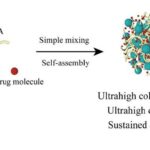
Credit: Frame Studio / Getty Images
Scientists at Xi’an Jiaotong-Liverpool University (XJTLU) and at Nanjing University have combined a widely used medical polymer with a natural blood protein to develop a new nanoparticle drug delivery system that the team says can carry much larger amounts of disease-fighting drugs and remain stable much longer than current nanoparticle systems. Headed by research lead Gang Ruan, PhD, Senior Associate Professor at XJTLU Wisdom Lake Academy of Pharmacy, the scientists carried out a series of in vitro and in vivo tests with the protein-polymer coassembly supraparticle (PPCAS), loaded with the anticancer drug doxorubicin (DOX). The results showed that compared with free DOX, PPCAS-DOX delivery reduced the side effects of DOX therapy. The team also carried out preliminary studies demonstrating the feasibility of PPCAS and PPCAS-DOX production scale up.
The team suggests the new nanoparticles could lead to improvements in how drug treatments for cancers and other diseases are delivered. Ruan, who is Director of Jiangsu Province Key Laboratory of Cell Therapy Nanoformulation (Construction), said, “We managed to solve two big problems at once. These new particles are made by mixing a medical-grade plastic called PLGA with albumin, a protein found in blood. Albumin already plays a role in carrying substances through the body and is used in some current cancer drugs. When mixed with PLGA in the lab, they naturally come together to form tiny, stable particles that are much better than using albumin or PLGA alone.”
The researchers reported on their study in ACS Applied Materials & Interfaces, in a paper titled “Protein−Polymer Coassembly Supraparticles as a Polyester-Based Drug Delivery Carrier with Ultrahigh Colloidal Stability and Drug Loading.”
Nanoparticles have demonstrated significant benefits as delivery carriers of drugs and macromolecules, the authors noted. “Poly(esters), especially poly(lactic-co-glycolic acid) (PLGA), are currently the materials of choice for clinical sustained-drug release formulations based on polymer nanoparticles, due to the long history of safe clinical use of these polymers.” Such delivery systems are especially useful for diseases like cancer, which may require steady, controlled doses of medication. However, many of the nanoparticles used today tend to clump together over time and usually carry only a small amount of a drug. This limits their effectiveness and can increase the chance of side effects caused by the materials used to carry the medicine. As the authors further noted, “Although many other biodegradable polymers, when made into nanoparticle forms, can also offer sustained drug release, the absence of any use in FDA-approved products leads to substantial, additional regulatory hurdles such as toxicology studies.”
Building on the lab’s previous research the new PPCAS technology developed by Guan and colleagues is formed by spontaneous co-assembly between the protein bovine serum albumin, and a hydrophobic polymer (PLGA as the model). “Here, we show that simple mixing of PLGA and BSA can lead to their spontaneous coassembly, forming protein−polymer coassembly supraparticles (PPCAS),” they stated.
The team explored two ways of loading a drug onto the particles. In one approach, the drug was added during the formation of the particles. In the other, the drug seeped into already formed particles using natural concentration differences of both the drug and the solvent. They found that combining the two produced better results than using either method alone.
“We further investigate two different methods to load DOX into PPCAS, namely, coassembly (with hydrophobic interaction as the primary driving force) and solvent diffusion (with concentration gradient as the primary driving force),” the investigators explained. “We find that combining the two loading methods can yield higher drug loading than using one method alone, supporting the complementary nature of the two loading methods.”
Combining both methods enabled ultrahigh loading of the model drug DOX into the PPCAS. “One of the most exciting things is that these particles can hold up to 40% of the chemotherapy drug doxorubicin by weight,” says co-first and co-corresponding author Zixing Xu, PhD, who was a visiting PhD student at XJTLU from Nanjing University. “That’s a big improvement over some existing treatments, such as Doxil, which hold about 11%. Carrying more drug with less material could help reduce side effects for patients.”
![A new nanoparticle made from the medical polymer PLGA and the blood protein albumin can carry higher doses of drugs and remain stable longer, offering improved delivery and fewer side effects. [Lin, et al. https://pubs.acs.org/doi/10.1021/acsami.5c07710]](https://www.genengnews.com/wp-content/uploads/2025/06/low-res-10-300x162.jpeg)
Having two different drug loading methods with different mechanisms also offers flexibility and adaptability to the PPCAS for loading different drugs, the investigators pointed out. Another major advantage of the PPCAS nanoparticles was their long-term colloidal stability—the particles stayed intact for more than six months, much longer than most current options.
Tests in lab-grown cells and in animals also showed that the new PPCAS nanoparticles delivered doxorubicin effectively while causing less damage to healthy tissues. When tested in a mouse model of breast cancer, PPCAS-DOX caused fewer side effects than free DOX. “… both low dose PPCAS-DOX and high dose PPCAS-DOX did not cause significant body weight loss; in stark contrast, both low dose free DOX and high dose free DOX caused significant body weight loss,” the researchers stated. “Tissue morphology study of major organs by Hematoxylin and Eosin (H&E) staining showed significant tissue damages in the two free DOX groups but no significant tissue damage in the two PPCAS-DOX groups, thus corroborating with the body weight loss study.”
Preliminary studies of production scale-up indicated that these nanoparticles can be made at larger scale without losing quality. “In future work, further studies on the scale-up of PPCAS production will be conducted,” the researchers acknowledged.
The researchers plan to continue exploring how these nanoparticles can be adapted to carry other types of drugs, potentially offering a more versatile and reliable platform for treating cancer and other chronic diseases.



